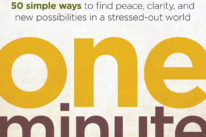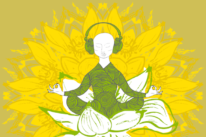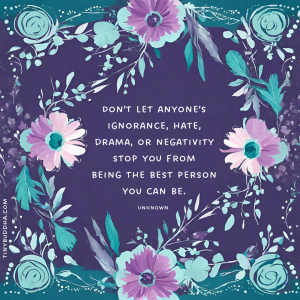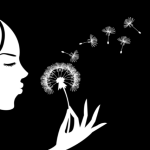
“You start watching your breath and all your problems are solved. It is not like that at all. You are working with the heart of your experiences, learning to turn towards them, and that is difficult and can be uncomfortable.” ~Ed Halliwell
Can mindfulness be bad for you?
I had been expecting it: Once you become a regular at it, mindfulness permeates all aspects of your life.
I only sit in meditation for twenty minutes daily (and a full hour on Sundays), but I carry its effects with me the rest of the time, elevated levels of awareness and all.
This is not to say that I constantly float on a blissful cloud. In fact, this sudden increase in mindfulness, even for someone used to deep introspection and resolutely committed to lucidity, comes at a certain cost. What I hadn’t expected was the actual weight of mindfulness.
Three months into the daily practice of mindful meditation, I had to admit that it was not solely eliciting the deep serenity I had hoped for. In fact, I realized that in some ways, I actually felt less happy than before.
I couldn’t precisely put my finger on it. All I knew was that things seemed heavier, more raw. How could that be? Wasn’t mindfulness supposed to help me transcend the vicissitudes of life? What was I doing wrong? Was I the only one in that odd situation?
I decided to do some research. It didn’t take long before I discovered evidence that mindfulness can indeed have “side effects.”
A quick online search showed me that I’m actually in very good company. Mindfulness, and the practice of meditation, has reportedly entailed significant “downsides” for a number of enthusiasts.
We come to mindfulness in the hope that it will constitute the path to peacefulness, often unaware that this path is paved with cracked and bumpy stones. Only after stepping onto that road do you realize how uncomfortable the process can be.
Just like therapy, meditating is difficult, sometimes painful.
The first and most obvious reason is that sitting still, quieting the mind, and focusing on the breath presents a real challenge. Many beginners and non-beginners complain of an overwhelming restlessness or, on the contrary, of an irresistible tendency to fall asleep (I belong to the latter category).
The second reason is that mindfulness has a way of annihilating our blissful ignorance. It offers an unexpected and unparalleled insight into our areas of vulnerability, the sides of us that we are not always prepared to welcome nonjudgmentally.
To get the most of it, one must recognize that the practice of mindfulness is dirty, hard work.
According to Willoughby Britton, a Professor of Psychiatry and Human Behavior at Brown University Medical School, the downsides of mindfulness range from mild to severe, and can manifest in various ways—from unexpected anger and anxiety all the way to depression and psychosis.
Mindfulness can exacerbate a number of mental health conditions, bring back to the surface traumatic memories, or simply force you to deal with things that had conveniently been swept under the rug.
Whatever your initial levels of stability (or instability), a lot can emerge in the first stages of the regular practice of meditation. Ready or not, you have to deal with it. It is disconcerting at best. In my case, it was sometimes downright depressing.
Picture a handful of Band-Aids applied to different spots on your body. Each Band-Aid conveniently covers an injury that you’re happy to ignore (or so you think).
Mindfulness is like peeling off the Band-Aids, one by one. It hurts.
Then you discover what’s under them: A bad cut here. A big bruise there. The occasional infected wound. A few badly healed scars. Mindfulness makes it hard to ignore that you are, under all those Band-Aids, actually hurting, or at least not entirely recovered.
To add insult to the injury, mindfulness has a way of preventing you from applying new Band-Aids. Things that we considered pleasant, and that help us deal with life’s vagaries, lose their appeal once we become aware of their true purpose and associated costs.
We use, in our daily lives, an arsenal of strategies, often without knowing it: thinking patterns, daily habits, activities we view as pleasurable “add-ons,” such as eating, shopping, staring at a screen, and so on. We don’t perceive those “pursuits” as Band-Aids. Aren’t they the spice of life?
The regular practice of meditation and a more mindful approach to life, however, sheds some light on our dependence. Any behavior that resists modification might indicate an addiction, even if it was just to chocolate, new running shorts, or social media.
I am now, more than ever, aware of my coping mechanisms, aware that rather than making life interesting, they mostly patch up an aspect of my existence that requires attention.
If I feel bored, tired, or stressed, no amount of sweets, sports gear, or Internet surfing will truly fill the void or fulfill the need.
Where I would mindlessly resolve to an old habit, this new knowledge stops me in my tracks. I pause, observe, notice the underlying emotion or sensation.
If I’m under work-related stress, such as a quickly approaching deadline, or a recalcitrant passage to translate, I will often have a sudden craving for sweets, or feel the pressing need to check my Facebook page. It’s not a coincidence, I know that now, but I needed mindfulness to realize it fully.
Now, instead of walking to the cupboard or opening a new tab in my browser, I stay put and take a deep breath. I skip the coping mechanism and refrain applying a new Band-Aid or replacing an old one.
Even my thought processes are modified. When certain situations repeatedly elicited the kind of stress that requires a Band-Aid, I was forced to reconsider, at least to a certain extent, the choices I had been making in various areas of my life: my career path, other types of commitments, and even some relationships. I realized I had too much on my plate and that I needed to respect my limits.
Accepting the fact that I indeed have limits was no small feat. Even if I have long been aware of some of my “rationalizations” and “compensations,” I have never faced life with such clarity, honesty, and courage. I am proud of it. I am also unsettled.
In spite of this, I am still fully committed to continue with my mindfulness practice. The cans of worms I am opening can be a handful, but I was carrying them anyway, and they were wearing me down. I choose to deal with them.
Things might feel very raw, but they also feel very real. I can already sense a new level of lightness and freedom on the other side of this demanding exercise.
I invite you to give it a try too. As we move along in our mindfulness practice, I trust that we can all find our own sweet spot, the place where an increased awareness meets a renewed sense of well-being.
For many, this will mean starting slow. When you incorporate mindful meditation into your life, don’t go for the three-day retreat right away. Not only will it be too demanding, it might even backfire.
Instead, simply find a quiet place where you can sit for at least five minutes, in silence, every day, and focus on the breath.
You may feel uncomfortable at first, as the feelings you formerly numbed or avoided emerge. Don’t let that deter you. If you embrace the discomfort, you’ll eventually gain the clarity needed to acknowledge and heal old wounds, break unhealthy patterns, and generally step onto the path to a more authentic life.
About Julie Saint-Mleux
When Julie is not busy peeling off her Band-Aids or contemplating the reasons why she put them on in the first place, she enjoys writing about health and wellness, and sharing slowly acquired (and often misplaced) pieces of wisdom. You can find her blog at happinessdishbestsavouredhot.blogspot.ca, and follow her on Facebook.













 Though I run this site, it is not mine. It's ours. It's not about me. It's about us. Your stories and your wisdom are just as meaningful as mine.
Though I run this site, it is not mine. It's ours. It's not about me. It's about us. Your stories and your wisdom are just as meaningful as mine.